Havana, Cuba
ms Veendam
Cuban Explorer
Day 5
Partly Cloudy - 72 Degrees
Cuba is an other like no other, a place of mystery, both wildly exotic and mildly dangerous in the American imagination. It evokes themes epic and eternal: paradise lost, revolution won, communism and dictatorship, oppression and poverty. The Cold War reached the boiling point here, the embargo built walls in the water. We felt the weight of that history sailing into Bahia de la Habana, shrouded in the murky darkness just before dawn, past the lighthouse at El Morro, and under the protective gaze of El Cristo, to our berth at Terminal Sierra Maestra San Francisco.
We began our P2P tour, and orientation to Havana, via bus with a drive-by of the Parque Central, the Capitol and El Gran Teatro.
True to the mission, Education and Cultural Exchange were the themes of the first stop, a Cuban Community Project. According to the tour description:
"Recent years have seen rise to many community projects designed to promote development and growth among the Cuban people. Learn about the locals who are taking the future of Cuba into their own hands. The community project associated with this tour is included to promote further understanding and interaction with the Cuban people."
In order to facilitate true people to people exchange, small groups visited different community projects. We stopped at Cabildo Quisicuaba.
According to their website cabildoquisicuaba.cult.cu (when the word "cult" is actually in the URL, you know it's going to be good):
Actions have been taken to influence the individual and collective life project of people living in this Municipality, prioritizing high-risk communities and bringing back to life the traditional popular culture, local micro-history, virtuosity of its inhabitants and their human values.
Our goal: a harmonious community, praiseworthy exponent of endogenous growth and local empowerment."
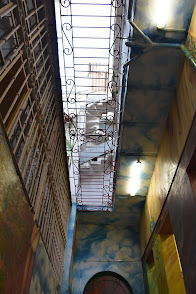 We filed into a narrow atrium of sorts in between two buildings, and settled gingerly onto a pair of rickety plastic chairs in the back to enjoy the show, which we couldn't really see, or hear. It had something to do with the traditional Afro-Caribbean religions of the Cuban People. Pretty much your standard folkloric show. Tres was fond of the mural, though we can't be sure if it's supposed to be culinary art or a political statement.
We filed into a narrow atrium of sorts in between two buildings, and settled gingerly onto a pair of rickety plastic chairs in the back to enjoy the show, which we couldn't really see, or hear. It had something to do with the traditional Afro-Caribbean religions of the Cuban People. Pretty much your standard folkloric show. Tres was fond of the mural, though we can't be sure if it's supposed to be culinary art or a political statement.After the presentation, we moved next door to the museum. And, that was the extent of our education and cultural exchange.
Having been duly acculturated, we took advantage of our first few moments on the ground in Havana to look around.
First Impressions: There is a richness far above the standard of living; a lushness that outstrips the greenscape; an intensity that belies the casual gate of people on the street; a saturation heavier than the relative humidity. Havana is almost dripping. You can stand on a corner in Paris and turn 360 degrees trying to frame a shot, unable to find a beginning or an end to the beauty. Havana overwhelms the senses to the same extent, in a very different way.
There is virtually nothing new. Anywhere. Everything is in some state of decay and disrepair. We know that Cuba's famous fleet of classic American cars is maintained with MacGyver labor and makeshift parts. The embargo has prevented importation of official training and name brand materials. That appears to be true of everything else as well.
Art is life. Public art is everywhere, standing proud, often against the backdrop of a city crumbling around it. So too, the architecture. Everything from Spanish-era colonial (below) to Soviet-era brutalist (coming soon) dots the cityscape, and succumbs to the same forces of time and entropy. It is at once inspiring and dispiriting.
Though it actually dates from before the revolution, our next stop is the heart of Communist Cuba, Plaza de la Revolución. At the head of the plaza, across the street, is the monument to José Martí, the Cuban nationalist who led its liberation from Spain. At 450 feet, it is Havana's tallest structure. The plaza itself can hold a million people, nearly 10% of the Cuban population. Images of Che Guevara and Camilo Cienfuegos adorn the office blocks to the North. The captions read, "Vas bien Fidel (Going well Fidel)" and "Hasta la victoria Siempre (Toward victory Always)."
The classic car show, always in motion, is just off the plaza.
This classic car led us right through the Byzantine-Romanesque gateway, the Puerta de la Paz, to the Necrópolis Cristóbal Colón, one of the largest cemeteries in the Americas at nearly 150 acres. With two million interred, and 40-45 more buried each day, it is a national monument to the personal monuments of lives past and passed.
Our respects paid, we continued through the city and out to the Malecón, the 5 mile boulevard along the waterfront where the locals gather in couples, families, and groups of friends. The waves are wild and often close the road when they breach the seawall. We passed the Hotel Nacional and the newly-reopened US Embassy.
Along the way, our class in Cuba 101 continued. There are two currencies in Cuba. The local currency is the Peso, supported by the government at a subsistence level for the people. The tourist currency is the CUC, which is pegged 1:1 to the American dollar. We got a supply of CUCs at the pier, so we are good to go. There is a general currency exchange tax of 3%, with an additional 10% tax on conversion of American dollars. $100 bought us 87 CUCs for the day.
The mantra "Socialism or Death" guarantees every Cuban a government job that pays the equivalent of 20 - 50 CUCs a month, but many augment their income with a private job as well. The burgeoning private sector can pay several times what the government does. Our tour guide, for instance, is a teacher. This is his private gig. The government job keeps most Cubans above the poverty line, but a second job is no guarantee of getting ahead. A decent house or apartment can cost the equivalent of 250 CUCs a month.
And, there is food rationing. The government issues ration cards that are good at bodegas where people can buy staples for pesos, rice, beans, coffee, etc. But, fresh meat, fish, and produce is sold at private markets for CUCs, often too expensive for the average Cuban. For dining out, there are restaurants, which are run by the government and charge pesos, while paladars are private establishments tha bill in CUCs.
We stopped for lunch in the open courtyard of a modest private hotel, a paladar. The meal was modest as well, but authentic and served with pride:
- Cuba Libres
- Pineapple and Guava Sodas
- Plantain Chips
- Salad of Cucumber, Tomatoes, Lettuce, & Cabbage
- Soup of Chicken, Corn, & Potatoes Served with Toast Rounds
- Ropa Vieja (Old Clothes)
Shredded Beef Stewed with Onions, Garlic, Red Pepper, Mushrooms, Peas, Green Olives, & Tomatoes - Yellow Rice
- Squash
- Rice Pudding
Ropa vieja might refer to old clothes, but it was as tough as old boots. Cuba is not known for great food, and given what we have learned about the cost and availability of ingredients, that is neither a surprise, nor a disappointment. They have shared their best with us, and we are appreciative. After lunch, we made our first purchase at the little store off the courtyard, a fifth of Havana Club for the road (and the water), and a litre to take home. Rum runs 5 CUCs a fifth, 6 - 18 CUCs a litre.
From ropa vieja to Havana Vieja, old Havana, and a walking tour of two of the four squares that define the historic district. Seaward of the plazas, one of the oldest forts in the Americas, Castillo de la Real Fuerza is now home to the Museo de Navegación.
The Plaza de la Catedral, and its namesake Catedral, both date from the 1700s. It's actually the newest of Old Havana's old squares.
I made a friend at the art museum.
Plaza de Armas is the oldest square in Havana Vieja. Originally Plaza de Iglesia in the early 1500s, it was renamed in the late 1700s when it was used for military exercises. Now lined with royal palms, cooled with shade and refreshed by a fountain, it's a lovely oasis.
Beyond the plaza, we walked toward the water, more classic cars, and the ship at Terminal Sierra Maestra San Francisco.
But, the tour hasn't come full circle just yet. We crossed to the East side of the harbor to get an up-close look at El Cristo, the 55 feet of Italian marble Jesus who greeted us this morning as we arrived in Bahia de la Habana.
El Cristo has kept watch over the ship and the harbor all day.
Fortress de San Carlos de la Cabaña is part of the sprawling Parque Histórico Militar Morro-Cabaña that also includes the Castillo de los Tres Santos Reyes Magnos del Morro, the fortress we sailed past this morning. Built between 1763 and 1774, La Cabaña is the largest Spanish colonial fort in the Americas.
When Tres goes to Vancouver, he has a favorite Cuban cigar, the Hoyo de Monterey Epicure No. 2. It is the perfect smoke, robust, but not a bully, a slow one-hour burn enjoyed from Stanley Park looking across Coal Harbor to the city lights. Timed just right, lit at 9:00 gun, with shallow puffs and deep conversation, it is the best way to end a night North of the border. "Mmmm...cinnamony." In a humidor at 65% humidity, these cigars will last for years, and the box is pretty cool too.
Our last stop on the tour was the Amacenes San Jose market. We poked around a bit, and then made our way through and out to the water.
Back at the pier, we stopped at the port shop for a Cuban coffee and some provisions. They say there is one cop for every block in Havana, but they have not been in evidence today. Still, the crime rate is incredibly low, and Cuba is known as the safest island in the Caribbean. With that in mind, and fortified with a jolt of caffeine and sugar, Tres set out on a walkabout, while I retreated to the cabin for a rest.
First, into Plaza de San Francisco de Asís across from the terminal. La Conversación, a set of three sculptures dedicated to detente, was donated by the French ambassador.
Next, North back toward Plaza de Armas and the Palacio de Los Condes de Santovenia, now the Hotel Santa Isabel.

















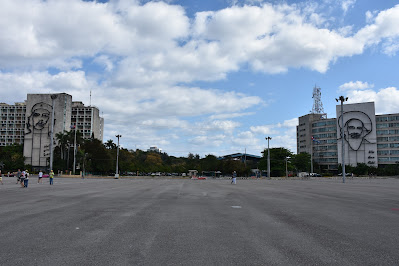



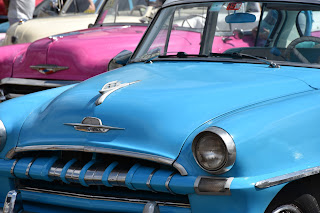
















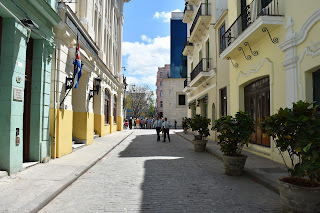


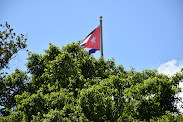














.png)







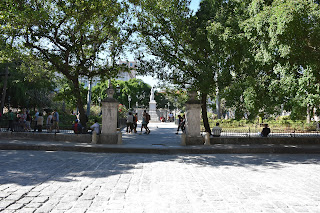









No comments:
Post a Comment